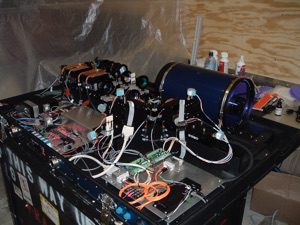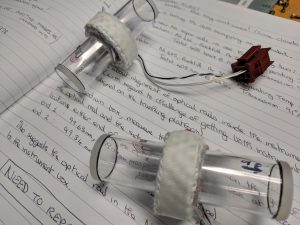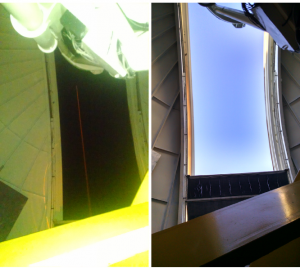Doppler-magnetograph
In collaboration with NASA/JPL we are developing a suite of four 20 cm aperture Doppler-magnetographs that image the full solar disk with a spatial resolution of 2 arc-seconds and a temporal resolution of 5 seconds. Each instrument uses a magneto-optical filter (MOF) to simultaneously provide the line-of-sight Doppler velocity and line-of-sight magnetic field strength at a given height in the solar atmosphere with a sensitivity of ~7 m/s and ~5 G, respectively, per image pixel. The suite of instruments is know as MOTH (for Magneto-Optical filters at Two Heights).

By using a different MOF in each instrument (Na, K, Ca and He), we are able to simultaneously measure the velocity and magnetic fields at different heights in the solar atmosphere, from the photosphere to the high chromosphere.
Two of the instruments (running Na at 589 nm and K at 770 nm) were deployed to the South Pole for campaign observations during the austral summers of 2016/17 and 2017/18. These instruments provided observations at ~ 400 km and 600 km above the base of the photosphere. The other two instruments (He at 1083 nm and Ca at 422 nm) are still under development. The helium instrument is the first of its kind and has provided high-quality intensity data. The next step is to develop velocity and magnetic field capability. The calcium instrument is also the first of its kind and is under construction (90% completed).

Each instrument is based on the same optical and mechanical design and, except for the MOFs and custom dielectric coatings on each set of optics, is essentially identical.
The primary purpose of the MOTH II instrument suite is to provide multi-height observations for helioseismic probing of the Sun’s interior and atmosphere via studies of the omnipresent magneto-acoustic-gravity waves in the solar atmosphere. However, the data also have relevance to Space Weather studies.
We are also developing Doppler-magnetograph systems that can be flown on high-altitude balloons, satellites, and even Cubesats.
Magneto-optical filters
Magneto-optical filters (MOFs) are a type of imaging atomic resonance filter with high-throughput and very narrow pass-bands (≈5 pm). They are extremely stable and have both high background rejection, thus making them very sensitive, and a wide acceptance angle, which enables a wide field-of-view compact optical design. They enable simultaneous measurement of intensity, Doppler velocity and magnetic field strength. Despite these outstanding characteristics, MOFs have only been achieved for a small number of elements/spectral lines: Na, K, Ce, Rb, Ca and He.

Along with researchers at the Jet Propulsion Laboratory and the Eddy Company, we are looking into the potential for MOFs for new elements with spectral lines that are relevant to SSA and space weather applications. For example Xe, N, H (remote thruster plume detection), and Ly-alpha (space weather). We are also investigating the potential for developing multi-band molecular MOFs. Lastly, we are investigating the use of sodium MOFs as part of the wavefront sensing system for daytime laser guide stars.


